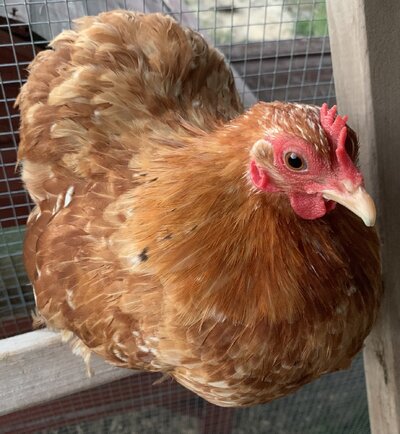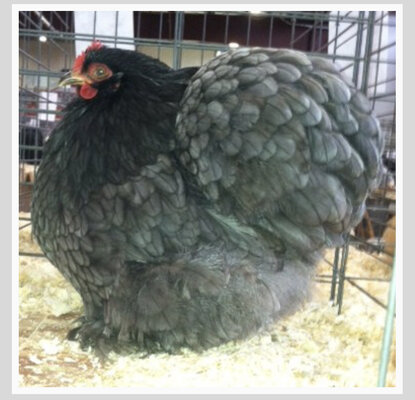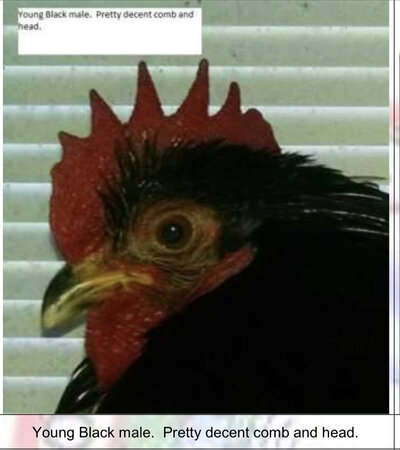Introduction
I started with a pair of MF Cochin Bantams about 2 years ago (2019). The parents of that pair were very bad type and color. The hen was way better in color.

(Photo from Corbitt Farms, not mine. Mom had good base coloring and Dad’s was all over the place. Cushion is way too small on both birds.)
However, the chicks from the two turned out as good starts. We got a trio as pets, right after beginning our chicken journey.
In 2020, I realized that the chickens we got could go far if bred correctly. So I selected the best hen of the two, still light, yet not too light in color, and bred to the rooster.


(Chase was just beginning to get fuller in feathers and type when he passed away. His flowering was looking amazing the days leading up to his death. But I won’t post pics of that, because he was deathly ill. We tried to save him, but we couldn’t. He was a bit long, needed a fuller cushion, and his comb was no good. He also had “weak wings” I assume.)


(Chloe never got the fullness she was supposed to get, but Chase was obviously better in type. Her color was a bit light, too. Part of her comb got pulled off and hung down the rest of her life. Type wise her tail is too small, breast isn’t full enough, she doesn’t have enough width, her head is carried not very well, but she carried her wings perfectly. In color, she could’ve been better, but she was a good start.)
That’s where I am currently. We set between 8 and 10 eggs, all of which were fertile, but, due to a power outage in hatch day, only 7 chicks made it. With them, we grew them out. We had five roosters and two pullets. Of the pullets, one was almost perfect in flowering, but her base was too light. She was very promising, yet she recently passed away. If the five roosters, two have good type compared with the others. They are wider, bigger, and better than the others. However, their cushions and tails are way too small. They are only 9.5 months old, so I assume they will fill out *some* in the next year. But they won’t be too great of quality. I think I will wait a little bit longer to see for sure who is the best to breed. One has more flowering, and I am currently trying to breed him with one of the hens. I’ve tried to avoid sibling x sibling breeding, but the 3 chickens we have now are the only ones left.


(Casey has much to like about her. Her color is finally to my liking, her eyes are huge, she has better type than her mate. Thing is, her cushion is still a bit small, she could be a tad shorter, she has an extra point in her uneven comb, she has a few stringy feathers, I think. Also, she isn’t too wide, her wings are a bit low in the photos, probably having to do with the heat in Florida already. Her flowering isn’t much, and she needs way more. However, again, it’ll keep developing.)
After getting a good number of chicks from them, I hope to do line breeding. I am no good at genetics now (at all, trust me), so feel free to correct anything I say. I will explain, to the best of my ability, these main points:
-Color/Flowering/Base
-Type
-My Future Breeding Wishes
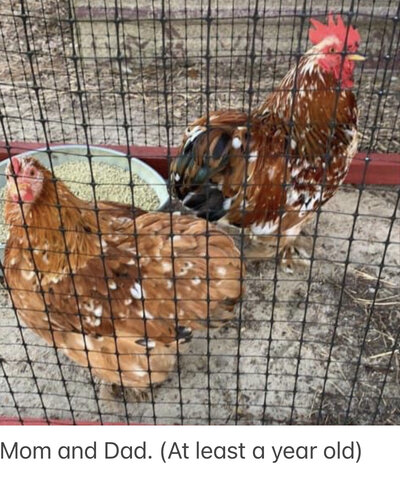
(Photo from Corbitt Farms, not mine. Mom had good base coloring and Dad’s was all over the place. Cushion is way too small on both birds.)
However, the chicks from the two turned out as good starts. We got a trio as pets, right after beginning our chicken journey.
In 2020, I realized that the chickens we got could go far if bred correctly. So I selected the best hen of the two, still light, yet not too light in color, and bred to the rooster.
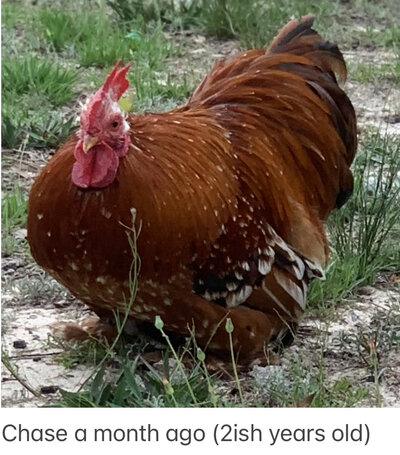

(Chase was just beginning to get fuller in feathers and type when he passed away. His flowering was looking amazing the days leading up to his death. But I won’t post pics of that, because he was deathly ill. We tried to save him, but we couldn’t. He was a bit long, needed a fuller cushion, and his comb was no good. He also had “weak wings” I assume.)


(Chloe never got the fullness she was supposed to get, but Chase was obviously better in type. Her color was a bit light, too. Part of her comb got pulled off and hung down the rest of her life. Type wise her tail is too small, breast isn’t full enough, she doesn’t have enough width, her head is carried not very well, but she carried her wings perfectly. In color, she could’ve been better, but she was a good start.)
That’s where I am currently. We set between 8 and 10 eggs, all of which were fertile, but, due to a power outage in hatch day, only 7 chicks made it. With them, we grew them out. We had five roosters and two pullets. Of the pullets, one was almost perfect in flowering, but her base was too light. She was very promising, yet she recently passed away. If the five roosters, two have good type compared with the others. They are wider, bigger, and better than the others. However, their cushions and tails are way too small. They are only 9.5 months old, so I assume they will fill out *some* in the next year. But they won’t be too great of quality. I think I will wait a little bit longer to see for sure who is the best to breed. One has more flowering, and I am currently trying to breed him with one of the hens. I’ve tried to avoid sibling x sibling breeding, but the 3 chickens we have now are the only ones left.
(I purposely used photos that wouldn’t lie about Cashew’s type—it’s pretty bad. But he still has a year to keep growing. He is missing a point on his comb, his wings hang low, his tail is tiny, he’s way too long, the usual. However, he is developing okay flowering— we have the white and some black— though we could always use more. His color—like his father’s—is pretty spot on. Flowering is the only thing to wait on. Usually around 3 years old, this color should be good on judging amount of flowering. That’s the end of adding flowers of this breed, as far as I know.)


(Casey has much to like about her. Her color is finally to my liking, her eyes are huge, she has better type than her mate. Thing is, her cushion is still a bit small, she could be a tad shorter, she has an extra point in her uneven comb, she has a few stringy feathers, I think. Also, she isn’t too wide, her wings are a bit low in the photos, probably having to do with the heat in Florida already. Her flowering isn’t much, and she needs way more. However, again, it’ll keep developing.)
After getting a good number of chicks from them, I hope to do line breeding. I am no good at genetics now (at all, trust me), so feel free to correct anything I say. I will explain, to the best of my ability, these main points:
-Color/Flowering/Base
-Type
-My Future Breeding Wishes
The Perfect Bird
To be a Millie Fluer, hens and roosters must have a specific base color. Cocks should be a reddish/orange/mahogany. Hens should have a red/dark buff color base. This is one of the biggest issues I see in this color, looking around. Usually hens are a lighter pale buff, when it should be a deeper and darker one. I’ve seen some cull a rooster because it’s base color was “not dark enough”, when it was the perfect deep red I look for in cocks. When hatching chicks, I see that all of them are a good buff color when dry. I want it to stay consistent to let me know that my line is consistent and pure enough to eventually breed to (a long shot, I know).
View attachment 2688730View attachment 2688733
(examples of good color above. Previous photos of Casey and Chase May give a better idea of true color. The lightings are way different in these pictures.)
My main issue in breeding for color is the flowering. My chickens do not have the good black and white mottling as they should. Each feather should have a line or “V” shaped black mark on the end of each feather, with white inside it, at the very end of each feather. I’d say my guys don’t have enough black on them. Around, I see Cochins with way too much black built up on the breast, hackle, and/or saddle feathers. That’s the #1issue. Beyond that, it’s getting a consistently good pattern.
View attachment 2688884
(The cock on the left has good flowering. The hen on the right has good flowering as well, but in a Cochin Bantam, we’d need less black and white so that the base color is still visible. Pic is a screenshot from google images.)
Moving on, we have the biggest issue: type. Though it’s hard to let a beautifully colored bird go, it’s necessary to making up a show quality bird. I’m hoping to improve my type. Cochin Bantams should be round balls with heads. There usually should be a distinction between the back and tail. Cushion must be full, and slightly lower than the head. The chicken itself should be wide from a view above. Here are some good typed birds from Cochinsinternational (I highly recommend looking at their website, online shows, and Education portion of the website).
View attachment 2689286View attachment 2689287
View attachment 2689288View attachment 2689289
And a good head on a Cochin Bantam:
(Also from Cochinsinternational)
View attachment 2689290View attachment 2689291
I’m a visual learner, so I hope this also helps you when trying to figure out type. And you can compare color to MF D’uccles that can also help out.
View attachment 2688730View attachment 2688733
(examples of good color above. Previous photos of Casey and Chase May give a better idea of true color. The lightings are way different in these pictures.)
My main issue in breeding for color is the flowering. My chickens do not have the good black and white mottling as they should. Each feather should have a line or “V” shaped black mark on the end of each feather, with white inside it, at the very end of each feather. I’d say my guys don’t have enough black on them. Around, I see Cochins with way too much black built up on the breast, hackle, and/or saddle feathers. That’s the #1issue. Beyond that, it’s getting a consistently good pattern.
View attachment 2688884
(The cock on the left has good flowering. The hen on the right has good flowering as well, but in a Cochin Bantam, we’d need less black and white so that the base color is still visible. Pic is a screenshot from google images.)
Moving on, we have the biggest issue: type. Though it’s hard to let a beautifully colored bird go, it’s necessary to making up a show quality bird. I’m hoping to improve my type. Cochin Bantams should be round balls with heads. There usually should be a distinction between the back and tail. Cushion must be full, and slightly lower than the head. The chicken itself should be wide from a view above. Here are some good typed birds from Cochinsinternational (I highly recommend looking at their website, online shows, and Education portion of the website).
View attachment 2689286View attachment 2689287
View attachment 2689288View attachment 2689289
And a good head on a Cochin Bantam:
(Also from Cochinsinternational)
View attachment 2689290View attachment 2689291
I’m a visual learner, so I hope this also helps you when trying to figure out type. And you can compare color to MF D’uccles that can also help out.
Moving Forward
With the pair I have now (Casey and Cashew), I plan to breed them and start by setting 5-8 eggs each hatch (unless fertility rates are low). From those chicks, I plan to select those with best type and color to breed back to Casey and Cashew. I will most likely cull the hens that are too light in color, the chicks with excess black on hackle, saddle, and/ or breast feathers. I will select the Cochins with the best cushions, width, and the roundest appearance. I will continue line breeding until I acquire some Mottled Cochin Bantams. With them, I will breed a rooster to my best hen and/or a hen to my best rooster. I want a trio with an amazingly typed rooster, a good hen, and a good frizzled hen to breed. I will take the offspring and cull all with excessive black, then pick those with best type. From the well-typed chickens, I will choose those with the best color. I plan to grow out the chicks at least 6-8 months before culling, unless I cull chicks for no feathering and middle toe. This will take a few years, I am aware, but I’m hoping to get the program up and running soon. Any thoughts from breeders I will gladly read. I would love to see what breeders think of the plans.
Hope to update soon—once chicks hatch / eggs are set / deciding culls.
Pics of the chicks:
Casey (breeder)—

Cushion

Width


Face


Wings

Hackle and Saddle

Breast

Willow and White feet
Cashew (Breeder, 2 weeks older than others)—

Cushion

Width


Face


Wings

Hackle and Saddle

Breast

Feet
Frog (potential breeder)—

Cushion

Width


Face


Wings

Hackle and Saddle

Breast

Willow or White Feet
Jesse (potential breeder)—

Cushion

Width


Face (don’t mind the glob of feathers, he was picked on when he fell weak. I separated him and he’s fine now.


Wings

Hackle and Saddle

Breast

Yellow Feet
Potential Breeder from the Past: Cindi, never got to maturity (6ish months old when she died)
Most recent pics I have—






(Note that she was very weak and pale upon taking these pics. But that’s the most recent before her death)
Do you think I picked the right rooster to breed to Casey (our only hen left), or do you think I should have chosen a different one? There’s still time left, as Casey hasn’t laid many eggs since her Dad died. And what about backup rooster?
I am just trying to build up numbers as of now, with only one hen that continues to skip on laying and sometimes lays softer shelled eggs, (I’ve tried and tried to get her calcium. There is currently oyster shells in a separate bowl for her.) I’m worried about losing her. I have three roosters to choose from if something happens to my main boy. I’ve set every single egg Casey has laid (except her first two, and all the soft shelled ones), yet we haven’t got much. I will update later, but look at this, set 6/3/21. Pic from day 4, am cheering this little fella on.

Of many many dud eggs, we came across a fertilized one (above). That one egg became a little chick (just hatched, still not completely dry).
This is Mira (Cole if a boy).


Hope to get pics of her after she’s dry. If she’s not a she, it will not be very helpful to the program unless she is the most typey rooster we have. If a girl, I can just breed to Cashew. This is the last egg we got from Casey, so hoping .
.
Updated (sorta) pics of the ‘breeders’:

Casey (Mom)

Frog
 Jesse (*possible but unlikely* dad)
Jesse (*possible but unlikely* dad)

Cashew (before he really bloomed, dad) He is the oldest of the four (by a few weeks), and has filled in more within the past 2-3 weeks. This photo was taken 2-3 weeks ago.
Hope to update soon—once chicks hatch / eggs are set / deciding culls.
Pics of the chicks:
Casey (breeder)—
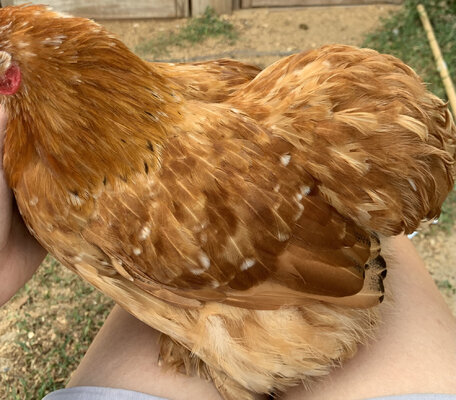
Cushion
Width


Face

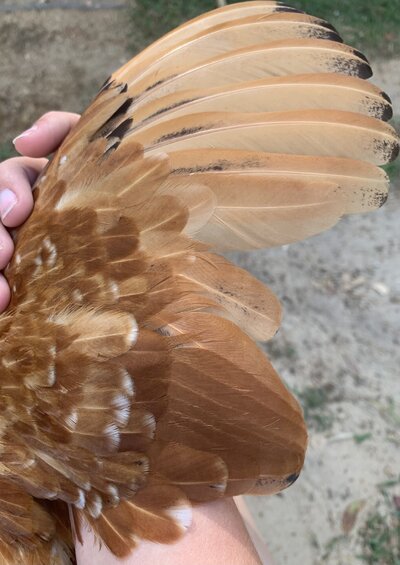
Wings

Hackle and Saddle
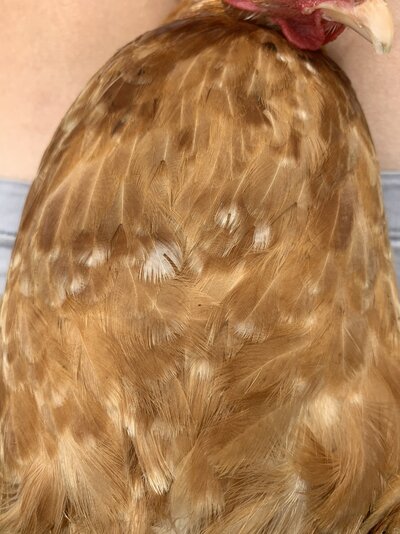
Breast
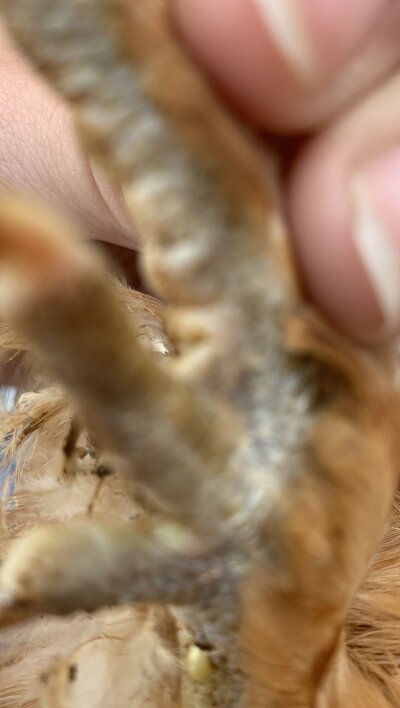
Willow and White feet
Cashew (Breeder, 2 weeks older than others)—
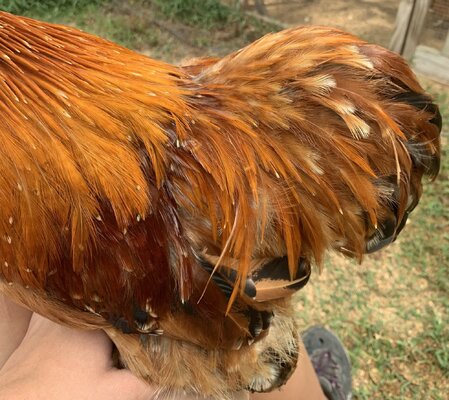
Cushion

Width


Face


Wings

Hackle and Saddle

Breast

Feet
Frog (potential breeder)—

Cushion

Width


Face


Wings

Hackle and Saddle
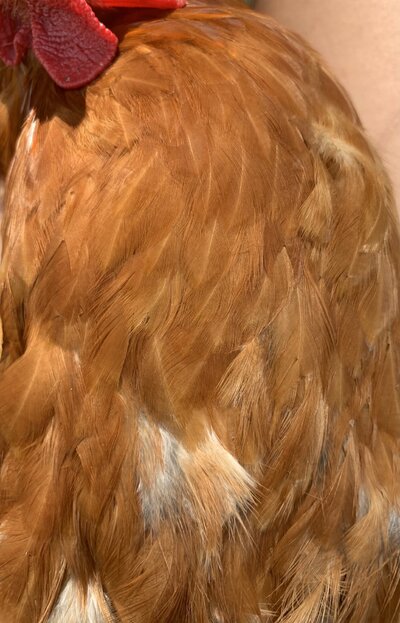
Breast

Willow or White Feet
Jesse (potential breeder)—

Cushion

Width


Face (don’t mind the glob of feathers, he was picked on when he fell weak. I separated him and he’s fine now.


Wings

Hackle and Saddle

Breast

Yellow Feet
Potential Breeder from the Past: Cindi, never got to maturity (6ish months old when she died)
Most recent pics I have—





(Note that she was very weak and pale upon taking these pics. But that’s the most recent before her death)
Do you think I picked the right rooster to breed to Casey (our only hen left), or do you think I should have chosen a different one? There’s still time left, as Casey hasn’t laid many eggs since her Dad died. And what about backup rooster?
I am just trying to build up numbers as of now, with only one hen that continues to skip on laying and sometimes lays softer shelled eggs, (I’ve tried and tried to get her calcium. There is currently oyster shells in a separate bowl for her.) I’m worried about losing her. I have three roosters to choose from if something happens to my main boy. I’ve set every single egg Casey has laid (except her first two, and all the soft shelled ones), yet we haven’t got much. I will update later, but look at this, set 6/3/21. Pic from day 4, am cheering this little fella on.
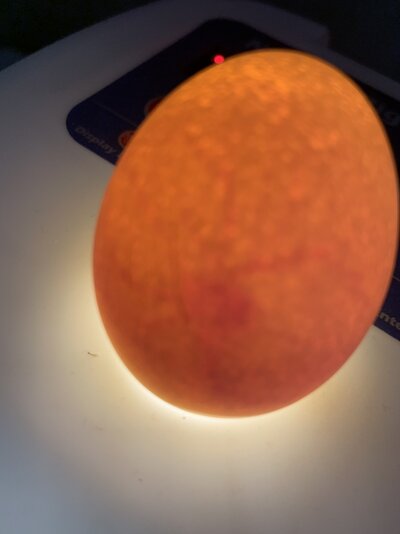
Of many many dud eggs, we came across a fertilized one (above). That one egg became a little chick (just hatched, still not completely dry).
This is Mira (Cole if a boy).


Hope to get pics of her after she’s dry. If she’s not a she, it will not be very helpful to the program unless she is the most typey rooster we have. If a girl, I can just breed to Cashew. This is the last egg we got from Casey, so hoping
 .
.Updated (sorta) pics of the ‘breeders’:

Casey (Mom)

Frog
 Jesse (*possible but unlikely* dad)
Jesse (*possible but unlikely* dad)
Cashew (before he really bloomed, dad) He is the oldest of the four (by a few weeks), and has filled in more within the past 2-3 weeks. This photo was taken 2-3 weeks ago.



